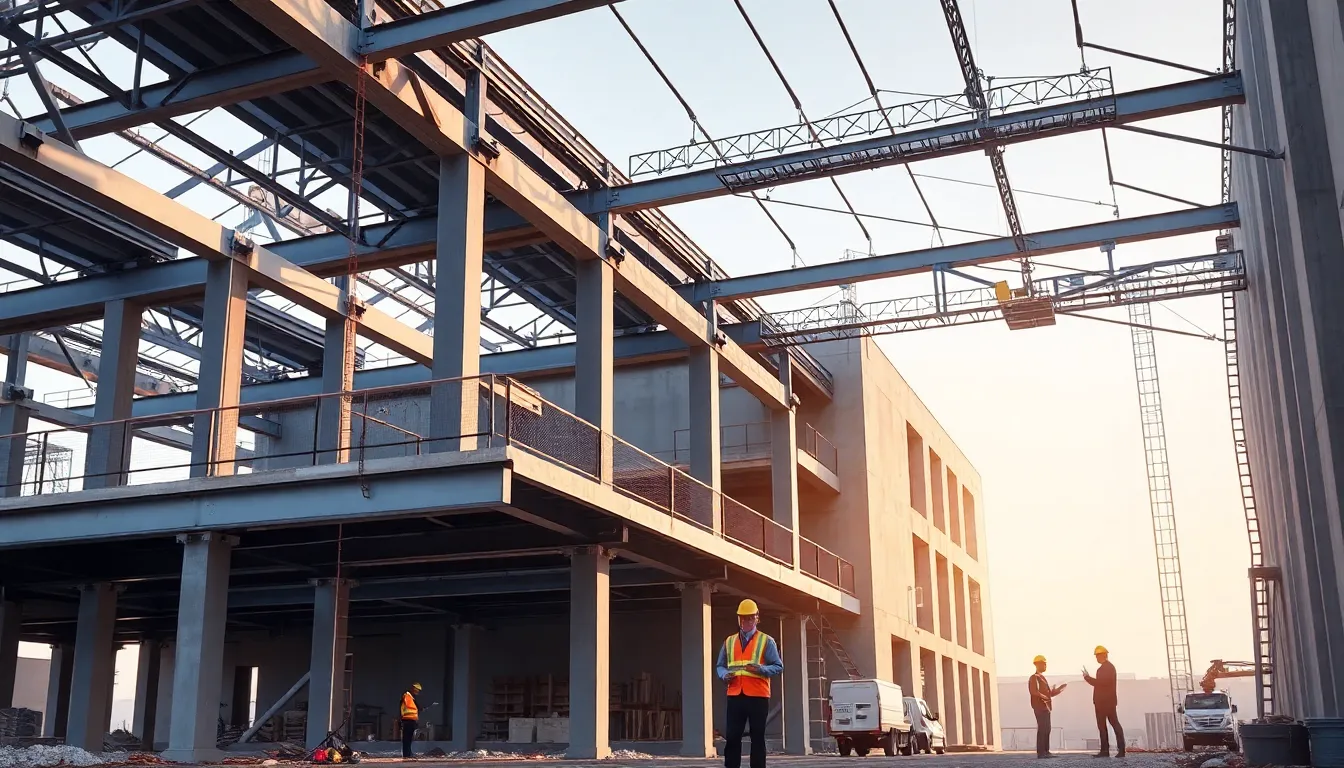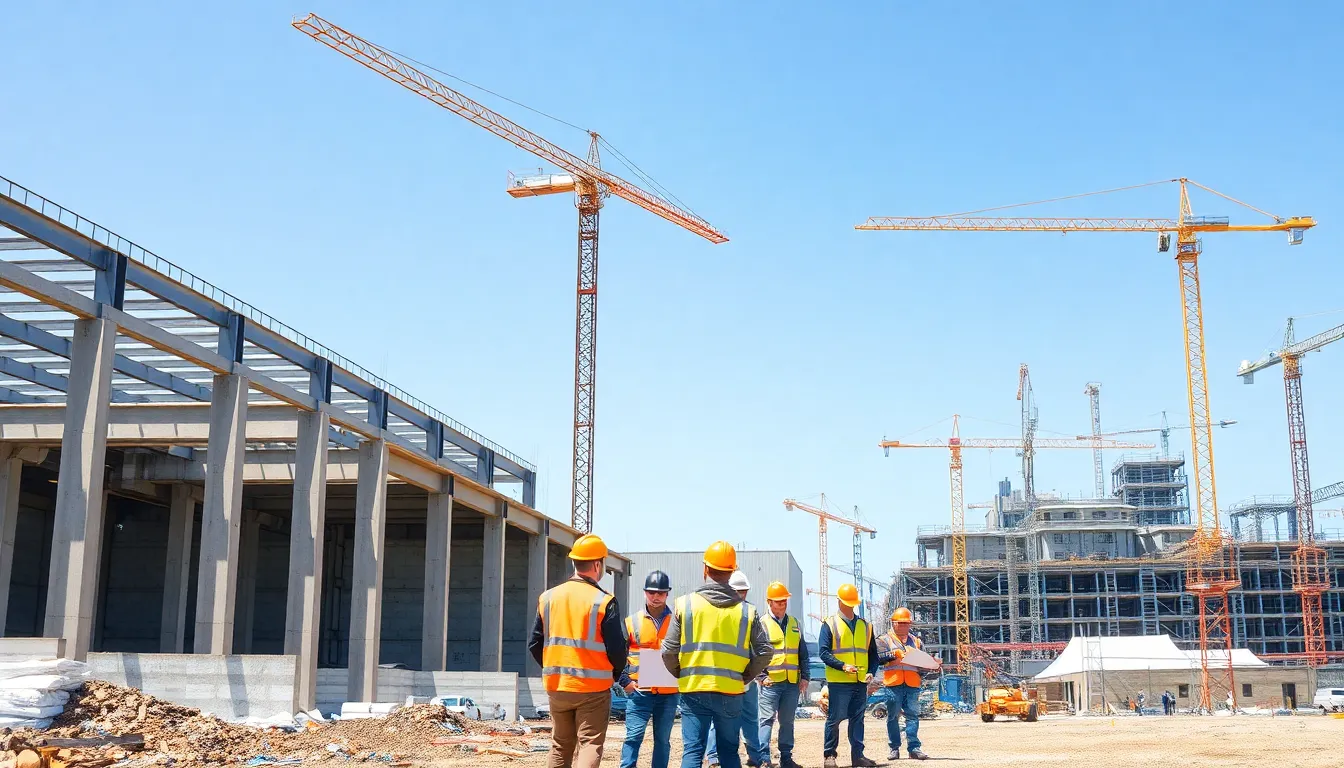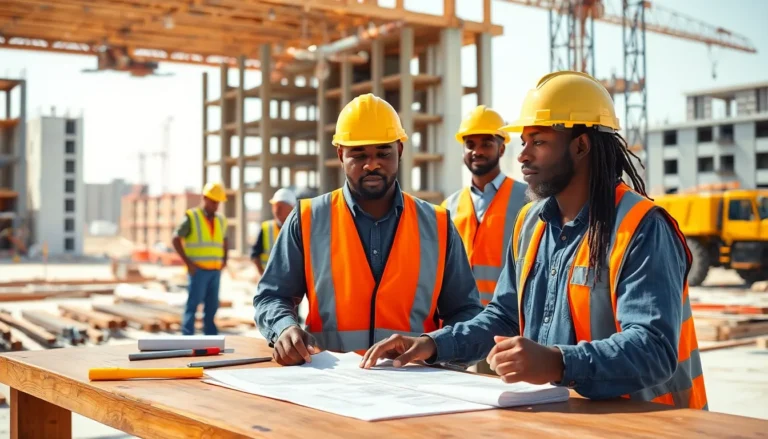Table of Contents
ToggleWhen it comes to industrial building construction, most people picture towering structures and heavy machinery. But there’s more to it than meets the eye. It’s a world where precision meets creativity, and engineers become the unsung heroes of progress. From warehouses that house the latest tech to factories that churn out everything from snacks to spacecraft, these buildings are the backbone of modern economies.
Imagine a place where steel beams dance like ballet dancers and concrete pours like a fine wine. It might sound like a construction-themed comedy, but industrial buildings are serious business. They’re not just structures; they’re the lifeblood of industries, designed to maximize efficiency while keeping safety in mind. Dive into the fascinating realm of industrial construction and discover how these monumental feats of engineering shape our world, one brick—or beam—at a time.
Overview of Industrial Building Construction
Industrial building construction encompasses various processes designed to create functional structures that support diverse industries. Industrial parks, manufacturing facilities, and distribution centers serve as vital components of the supply chain. Specific requirements, including load-bearing capabilities and safety regulations, guide the design and construction of these facilities.
Materials such as steel and concrete play crucial roles in shaping the durability and functionality of industrial buildings. Steel’s strength and flexibility meet structural demands, while concrete offers exceptional durability and fire resistance. Construction teams consistently prioritize efficiency during the building process, often employing advanced technologies and methods.
Building codes dictate the standards for industrial construction, ensuring safety and compliance while protecting workers and end-users. Sustainability practices are gaining traction, incentivizing builders to adopt eco-friendly materials and energy-efficient designs.
Engineering firms specialize in optimizing designs for performance and functionality, catering to the unique needs of various industries. Collaboration between architects, engineers, and contractors fosters innovation throughout the construction journey. Customization often becomes necessary for specific operations, enhancing productivity while meeting industry standards.
Timelines and budgets are critical factors in the planning phase. Adhering to project schedules and estimated costs is essential for successful implementation. Constant communication among stakeholders ensures challenges are addressed promptly, minimizing delays and maintaining quality.
Industrial building construction not only supports economic growth but also provides employment opportunities across multiple sectors. Engaging skilled labor plays a significant role in executing high-quality projects and meeting stringent deadlines. As the demand for industrial spaces rises, recent trends highlight the importance of adaptability in designs to keep up with evolving market needs.
Key Components of Industrial Buildings

Industrial buildings consist of several key components that ensure functionality and compliance with regulations. Understanding these components helps stakeholders optimize design and construction processes.
Structural Design
Structural design focuses on creating frameworks that withstand various loads and environmental factors. Engineers prioritize stability and durability, ensuring structures can handle equipment, inventory, and personnel. Load-bearing walls, columns, and beams work together to distribute weight evenly. Open layouts facilitate efficient workflows and accommodate specialized machinery. Additionally, flexibility in design allows adaptation for future expansions, leading to cost-effective long-term solutions.
Materials Used
Materials selected for industrial buildings play a significant role in their longevity and performance. Steel stands out for its strength and versatility, commonly used in frames and roofs. Concrete, known for its load-bearing characteristics, forms foundations and walls. Advanced composites and prefabricated components gain traction for efficiency and sustainability. Eco-friendly materials like reclaimed wood and recycled metal offer options for sustainable practices. Each material choice must align with local regulations and industry standards to ensure safety and effectiveness.
Construction Process
The construction process involves a systematic approach divided into key phases. Understanding these phases ensures successful project execution.
Planning and Design Phase
Planning and design phase entails detailed analysis and preparation. Accurate site assessments inform design choices. Architects create blueprints that adhere to regulatory standards, ensuring compliance with building codes. Engineers assess load-bearing capabilities to guarantee safety and functionality. Collaboration among stakeholders, including contractors and clients, refines the design. Clear communication throughout this phase promotes efficiency, streamlining decision-making processes. Timelines and budget considerations become essential to align project expectations. Successful completion of this phase lays the groundwork for the subsequent construction activities, establishing a solid foundation for the entire project.
Construction Phase
Construction phase marks the transition from plans to physical structures. Ground preparation begins with excavation and grading, creating an ideal site for building. Workers install foundational elements, often using concrete for stability and durability. As structures rise, steel beams provide essential support while ensuring resilience under various loads. Continuous quality control checks ensure materials and construction practices meet industry standards. Skilled labor plays a critical role during this phase, optimizing workforce efficiency for timely project completion. Safety protocols remain paramount, safeguarding workers on-site. Ultimately, this phase materializes the vision outlined in the planning stage, transforming blueprints into functional industrial buildings.
Challenges in Industrial Building Construction
Industrial building construction faces several challenges, primarily due to the complexity of projects and their requirements.
Regulatory Compliance
Ensuring compliance with building codes presents a significant challenge. Various regulations govern safety, environmental impact, and construction methods. Projects often require numerous permits before construction can commence. Each local jurisdiction imposes specific requirements that vary by region. Failure to comply leads to costly delays and potential legal issues. Engineers and architects play essential roles in navigating these regulations to ensure all standards are met.
Budget Constraints
Budget constraints frequently impact the design and construction phases. Rising material costs create financial challenges for developers and contractors. Managing expenses while maintaining quality becomes crucial. Adjustments to project scope may occur to align with financial limitations. Efficient project management practices help control costs without sacrificing safety and functionality. Collaborating with suppliers can also lead to cost-saving opportunities while ensuring high quality.
Future Trends in Industrial Building Construction
Sustainability increasingly drives innovations in industrial building construction. Architects and engineers now emphasize eco-friendly materials that lower environmental impact while maintaining durability. Renewable resources, like recycled steel and reclaimed wood, are gaining popularity, bolstering green building certifications.
Smart technology integration enhances operational efficiency. Automation tools streamline processes, reduce waste, and improve safety. Sensors monitor structural health and energy consumption in real-time, offering valuable data for ongoing maintenance and optimization.
Modular construction methods also reshape industrial spaces. Off-site fabrication allows for quicker assembly onsite, minimizing labor costs and site disruptions. This technique fosters customization, enabling developers to meet specific industry requirements without significant delays.
3D printing continues to expand its role in the industry. This technology allows for rapid prototyping of building elements, reducing lead times and material waste. Complex designs that were once impossible can now be realized using advanced printing techniques.
Flexible designs become more critical to address shifting market demands. As industries evolve, spaces need to adapt quickly to accommodate changing uses. Open floor plans and expandable structures provide the necessary versatility for future-proofing investments.
Data analytics plays a key role in decision-making processes. Analyzing trends and consumer behaviors enables builders to predict future demands, aligning construction plans with market needs. This approach leads to investments that yield long-term returns.
Collaboration among stakeholders epitomizes a successful project. By engaging architects, engineers, and contractors from the outset, teams can align their visions and streamline workflow. This collaborative spirit fosters innovation and enhances overall project quality.
Industrial building construction is a complex yet fascinating field that combines engineering precision with creative design. As the demand for efficient and sustainable industrial spaces continues to grow, the industry must adapt to new technologies and practices. Collaboration among architects engineers and contractors is essential for overcoming challenges and ensuring projects meet both safety and regulatory standards.
The future of industrial construction looks promising with innovations like modular design and smart technology paving the way for enhanced efficiency and reduced waste. By embracing these advancements and prioritizing sustainability, the industry can continue to play a vital role in supporting economic growth and meeting the evolving needs of various sectors.







